“Great recipe! We always bought the ‘CookDo’ Mabo Tofu sauce when we lived in Japan. Needless to say…this is WAYYYY better! Thanks for the recipe.”
– Spence
What is Mabo Dofu?
Mabo Dofu (マーボー豆腐) is the beloved Japanese adaptation of Sichuan China’s famous “Mapo Tofu” dish. Unlike its fiery Chinese counterpart, the Japanese version features tofu and ground pork in a rich, savory sauce with a gentle heat that makes it perfect for family dinners.
This 30-minute weeknight wonder has become a cornerstone of Japanese home cooking-the dish busy parents rely on when they need something nutritious, delicious, and universally loved. Growing up in Japan, Mabo Dofu was sometimes served as part of my school lunch and I always eagerly waited for those days.
While mapo tofu originated in China’s Sichuan province, mabo dofu has been fully embraced by Japanese cuisine since the 1970s. It’s as fundamental to Japanese family meals as spaghetti bolognese is to British households – a reliable, beloved staple that appears frequently on dinner tables.
This recipe captures that perfect balance – authentic enough to satisfy your craving for that distinct Japanese flavor, yet adaptable to suit even the pickiest eaters in your family.
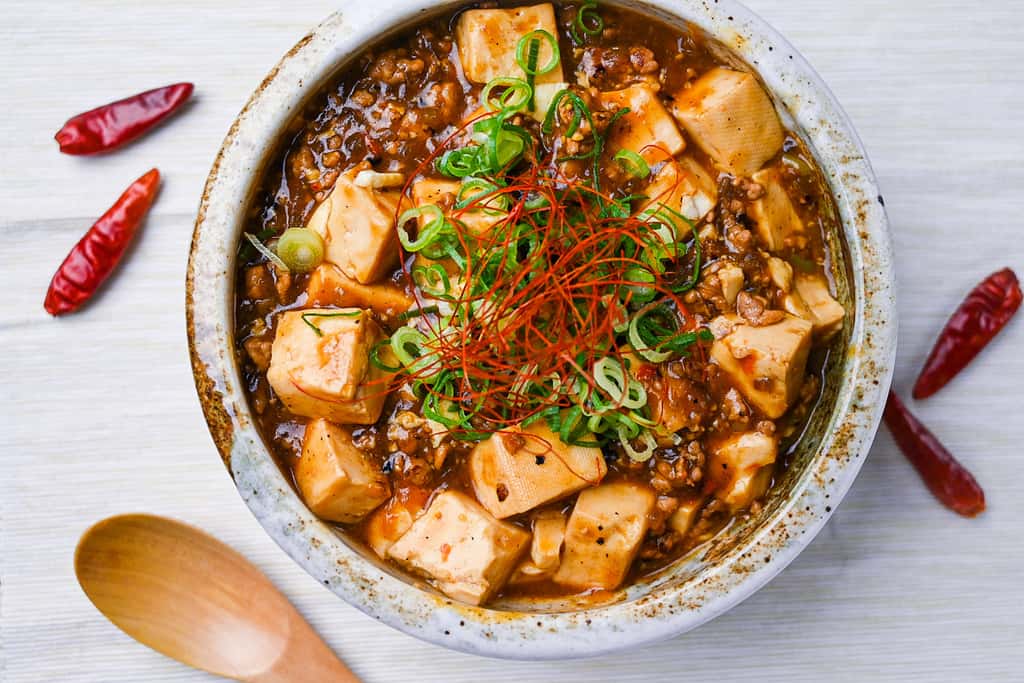
Tofu Types in Mapo Tofu: Silken vs. Firm
When making mapo tofu, the question that many people have is, “What type of tofu should I use? This dish can be made with either silken (kinugoshi/絹ごし) or firm (momen/木綿) tofu, but each offers distinct textures and cooking properties.
| Feature | Silken Tofu | Firm Tofu |
|---|---|---|
| Texture | Smooth, soft, creamy | Dense, slightly rough |
| Water Content | High (more moisture) | Low (well-drained) |
| Cooking Stability | Fragile, breaks easily | Holds shape well |
| Flavor Absorption | Mild, less absorption | Absorbs flavors well |
| Preparation Tip | Parboil to strengthen structure | Drain excess moisture before use |
| Best For | Soft, silky mouthfeel, perfect if you’re already used to deal with silken tofu | Perfect choice for beginner, or if you want to streamline the cooking process |
In short, choose firm tofu for stability and ease of cooking, while silky tofu offers a luxurious texture but requires extra preparation. Some softer varieties of firm tofu can also offer a balance of structure and smoothness.
I personally recommend using the firm tofu or the firmer side of the silken tofu, as I believe that one of the most important essences of family-style Japanese mapo tofu is ease of preparation.
Choosing Ground Meat: Pork, Others, and Vegetarian Alternatives
There is no doubt that ground pork is the most commonly used meat in mapo tofu in Japan. But that doesn’t mean you can’t make this dish without it!
Some Chinese restaurants in Japan even use ground beef for its bold and deeper flavor. If you use beef at home, choose a leaner cut or mix it with pork. For a lighter alternative, ground chicken or turkey can be used, although they contain less fat and have a milder flavor. To compensate, I recommended increasing the use of oil or oyster sauce to enhance the richness.
Vegetarian alternatives such as soy mince can also be used! Cooking with a little more oil and increasing the amount of miso helps create a richer flavor!
To make it vegetarian, replace the chicken bouillon with vegetable bouillon and the oyster sauce with a rich alternative such as mushroom sauce along with the ground pork alternative!
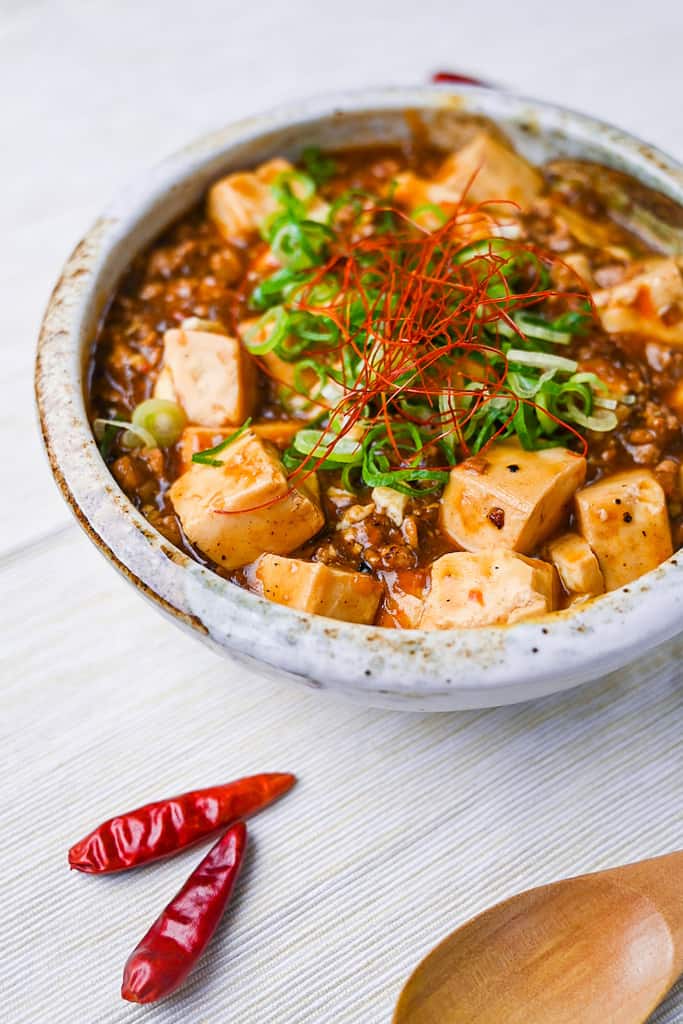
Visual Walkthrough & Tips
Here are my step-by-step instructions for how to make Mabo Dofu at home. For ingredient quantities and simplified instructions, scroll down for the Printable Recipe Card below.
If you prefer to watch the process in action, check out my YouTube video of this Mabo Dofu recipe for a complete visual walkthrough!
Heat a frying pan over medium heat and when hot, add the ground pork with a pinch of salt and pepper. If you are using a nonstick pan, the pork will usually have enough fat to keep it from sticking, but you can add a little oil if necessary.
Break up the meat with a wooden spatula as it cooks, and continue to brown until the meat releases its fat.
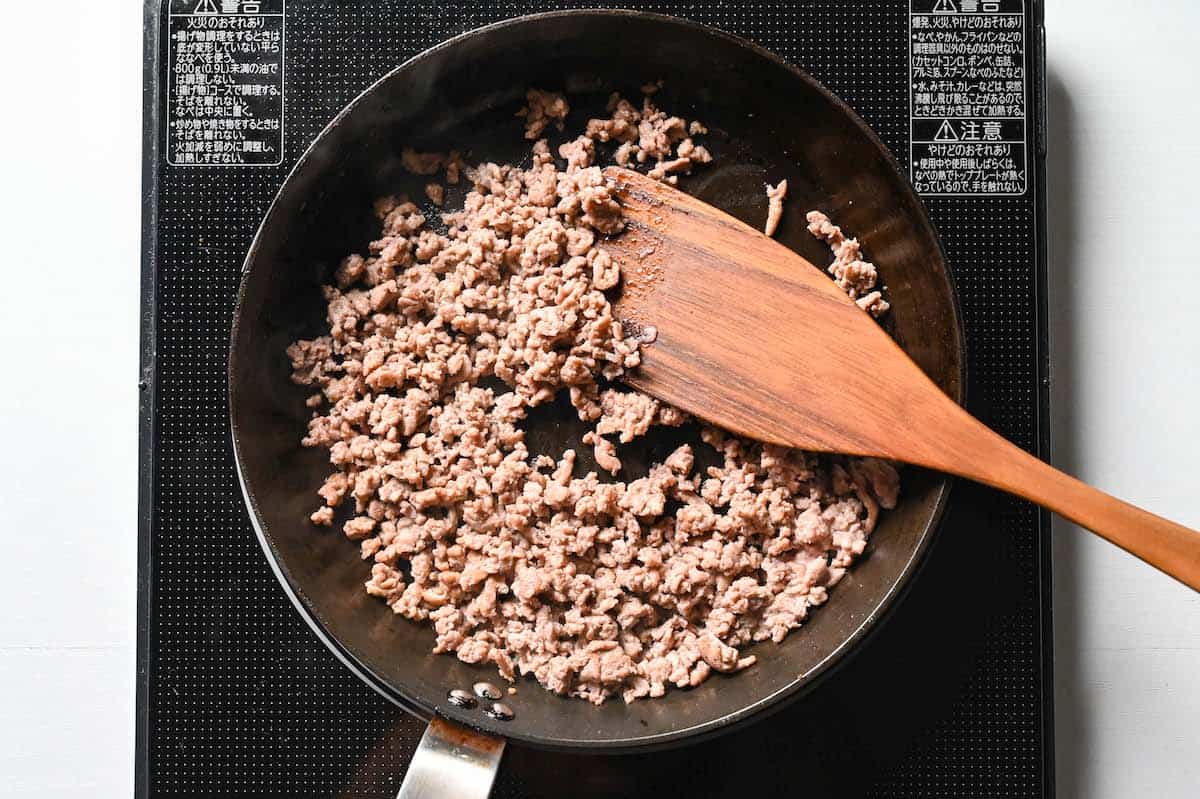
This step is important for developing deep flavor. When pork is properly browned (not just cooked), the Maillard reaction creates rich umami compounds that form the foundation.
Add the finely diced onion to the browned pork and fry until slightly softened and translucent, about 2-3 minutes. The onion will release moisture that helps pick up those flavorful browned bits from the pan bottom.
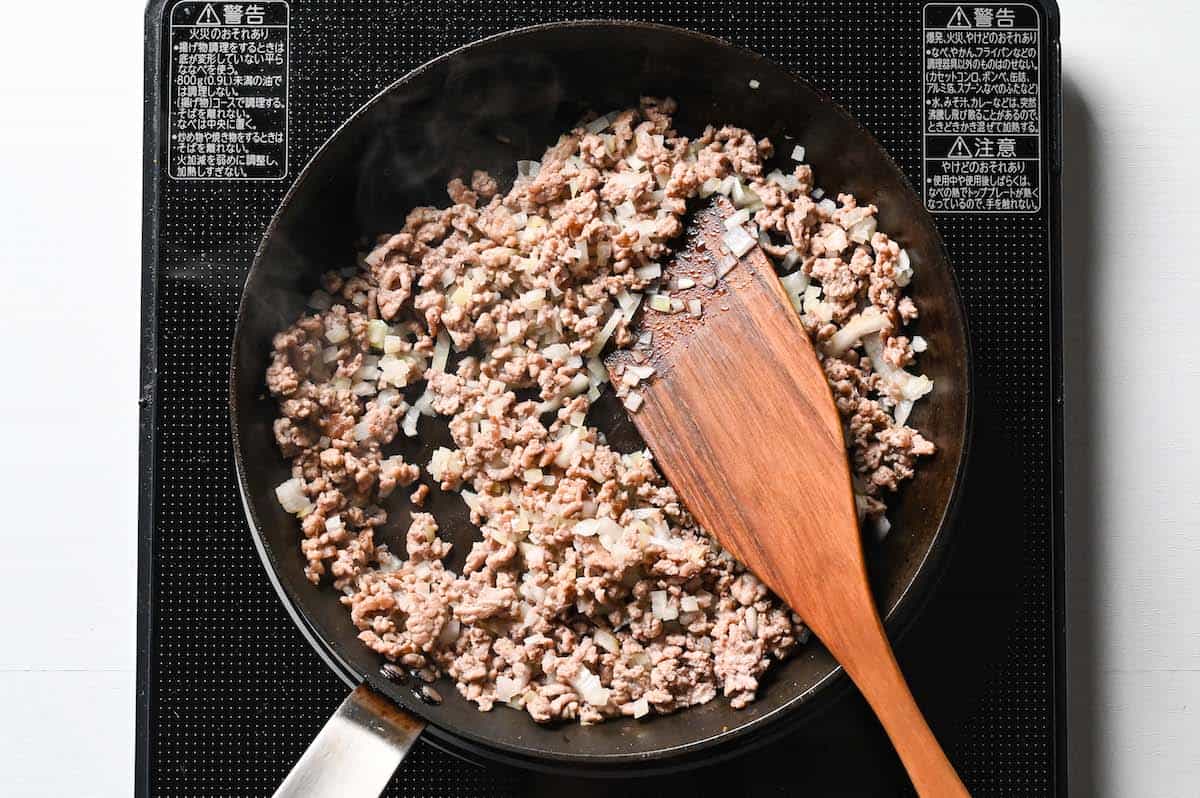
Add the sake, soy sauce and miso paste to the meat-onion mixture and mix thoroughly. This early seasoning layer helps the meat absorb flavors while continuing to cook, creating a more complex taste profile in the final dish.
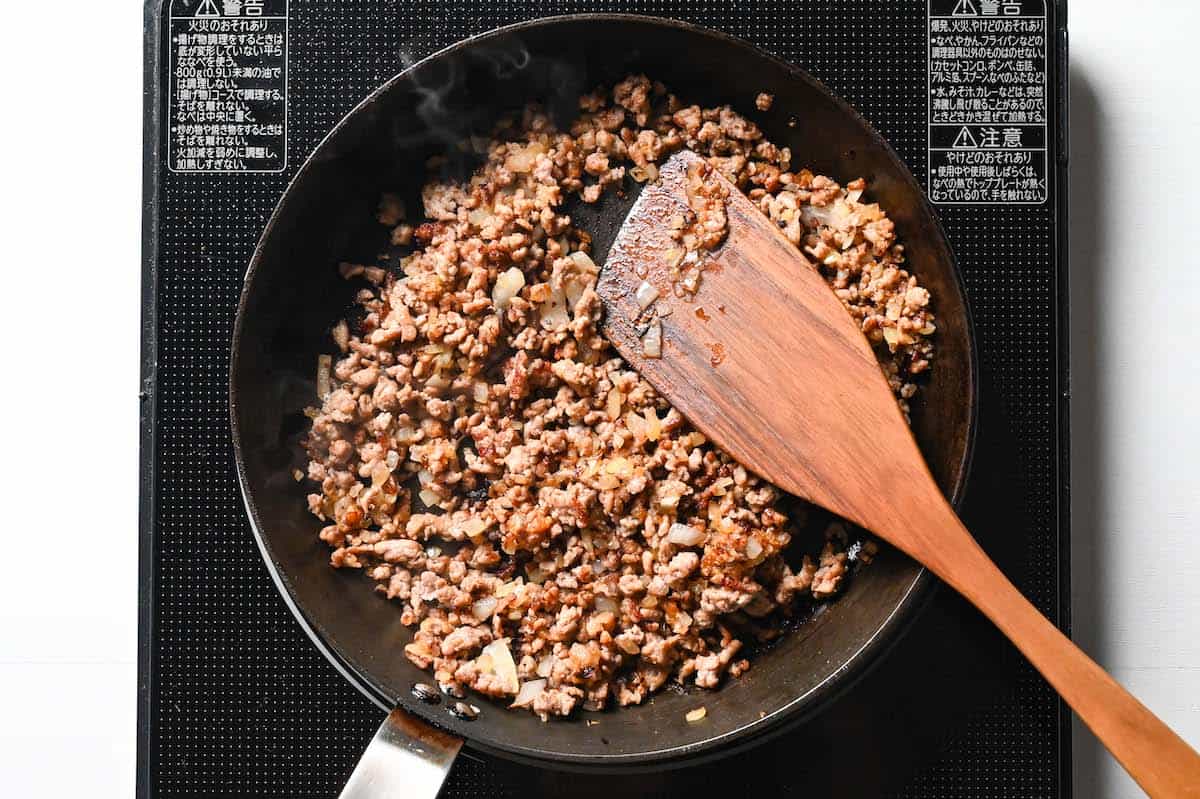
I used yellow (awase) miso paste, but if you have red and white, you can make yellow by mixing them in a 50/50 ratio. But don’t stress too much about this! You can make this mabo dofu tasty with either red or white miso too.
Red miso (like Hatcho miso) will give a deeper, more intense flavor, while white miso creates a gentler, slightly sweeter profile. If using white miso, you might want to add a touch more soy sauce to balance the flavors.
Miso paste is one of the biggest things that separates Japanese-style mapo tofu from traditional Sichuan versions. It contains glutamic acid, which adds a complex layer of umami that blends beautifully with the tofu.
Push the seasoned meat to one side of the pan and add toasted sesame oil, chili bean paste (toban djan), and grated garlic (or garlic paste) to the empty space. If you want, you can add 1 teaspoon of freshly grated ginger along with the garlic as well.
Mix the seasonings together and fry for about 30 seconds or until fragrant, then stir into the meat until evenly distributed.
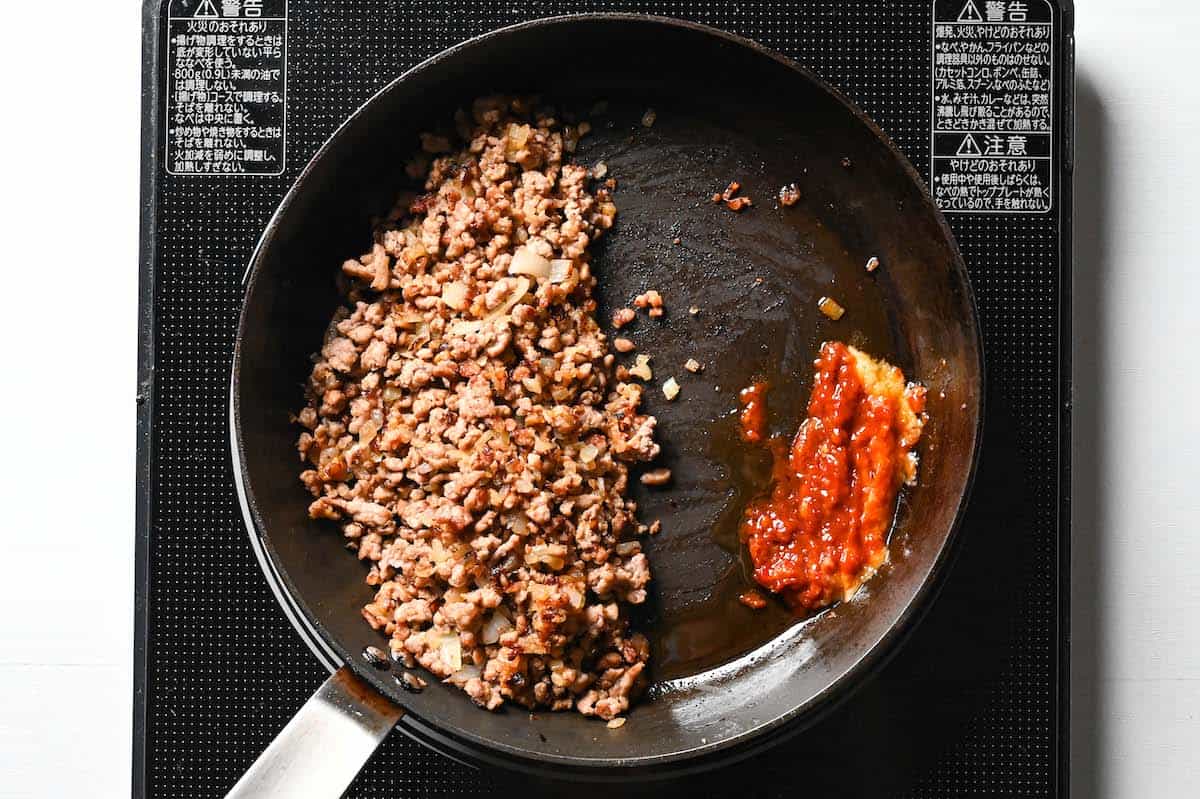
If you’re cooking for a family with those sensitive to spice, you can control the heat level by adjusting the amount of toban djan. For a very mild version, use just 1/2 to 1 teaspoon. For medium heat that most adults appreciate, try 1/2 tablespoon.
And don’t worry about residue stuck to the pan bottom! If you’re using a cast iron pan, you might see a slightly caramelized layer of miso, chili bean paste, and ground pork forming. This is a good thing. The Maillard reaction creates rich umami flavors and aromatic compounds.
After adding the chicken bouillon, be sure to scrape the browned bits from the bottom of the pan with a spatula to deglaze the pan and incorporate these concentrated flavors into your dish.
Pour the chicken stock into the pan. Gently add the diced firm tofu (2 to 3 cm/¾ to 1-inch cubes work best). Bring the mixture to a boil, and when it starts to bubble, reduce the heat to a simmer.
Gently add and stir the tofu to maintain its shape.
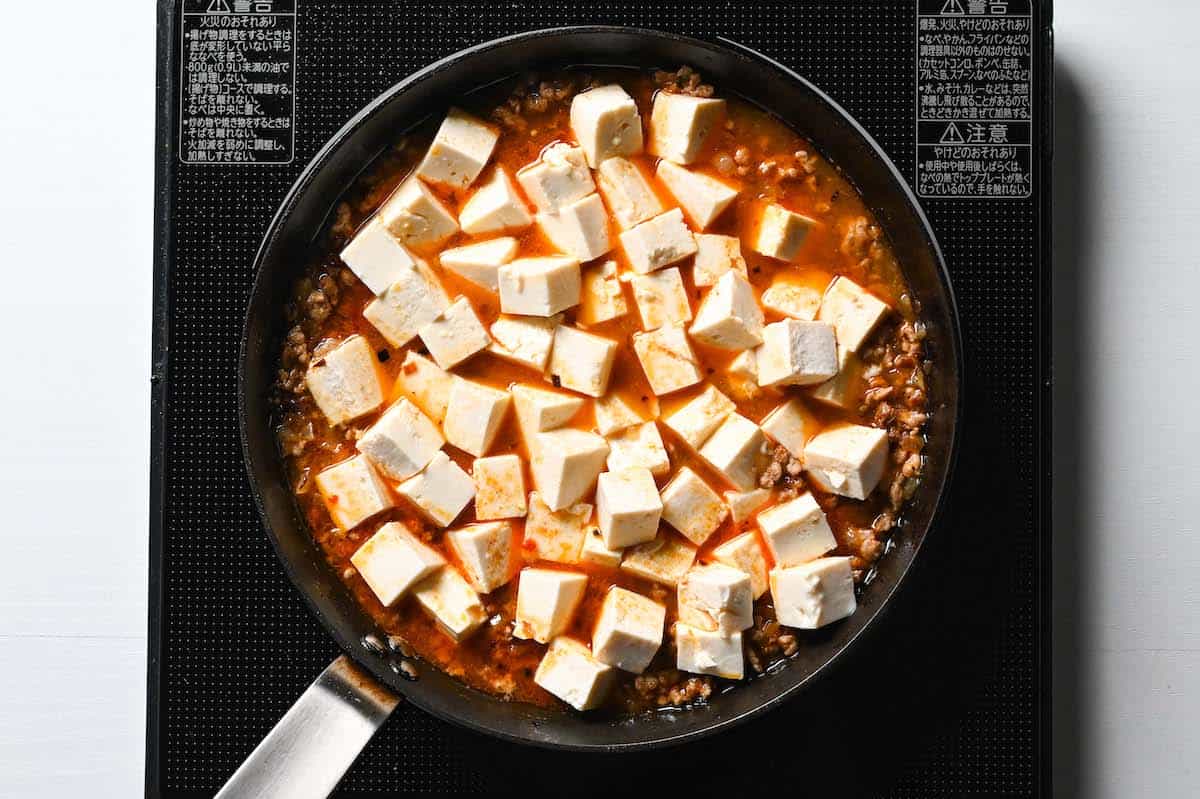
This dish is a Chinese-inspired dish, so I recommend using an Asian-style chicken bouillon to make the stock. But of course, you can also use other types of bouillon, so use what works best for you.
Another option is to use dashi stock with a tiny bit of extra oyster sauce. This will mellow the richness of the pork and create a more refined flavor.
Add the sake, soy sauce, oyster sauce, and black pepper to the simmering liquid. Mix gently by shaking the pan rather than stirring aggressively, which helps season the sauce without breaking the tofu.
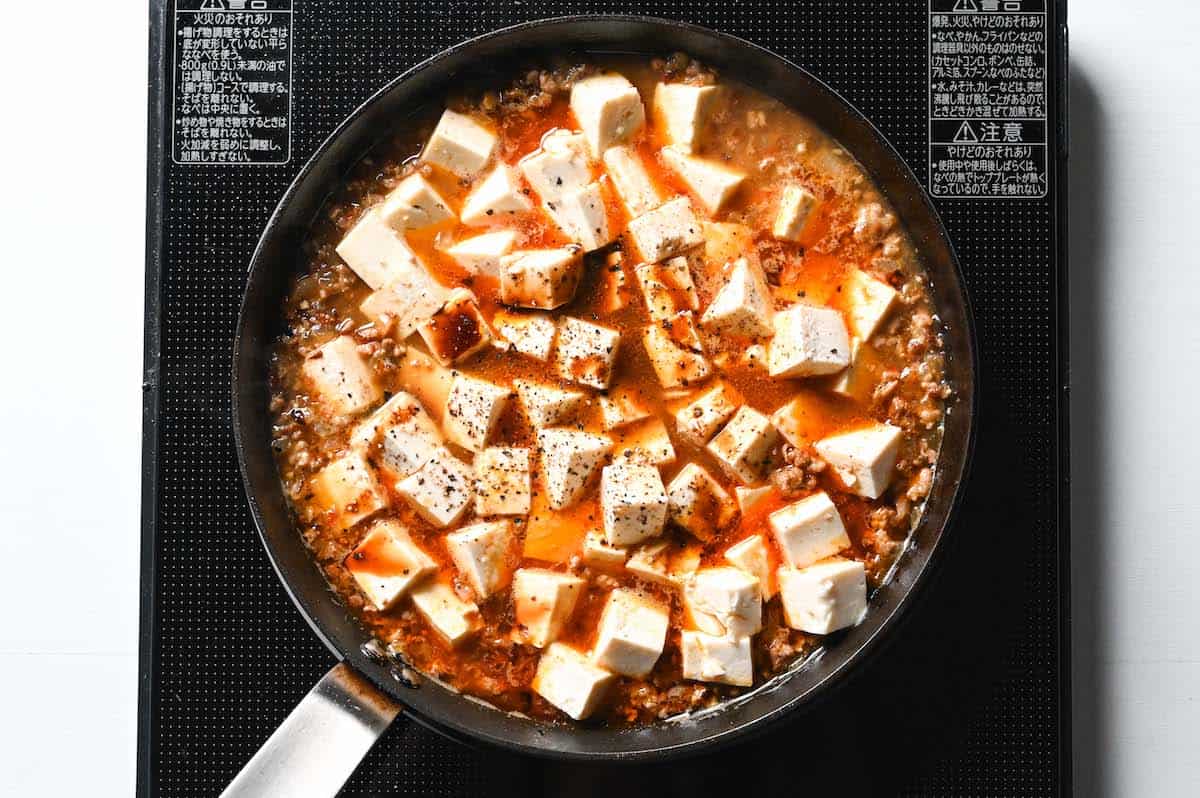
This recipe uses this two-step seasoning approach (first the meat, then the broth) to create deeper flavor complexity. This ensures that each element is properly seasoned and creates a more harmonious final dish.
If you don’t have sake, you can substitute dry sherry or dry white wine.
Simmer the mixture uncovered for 6-8 minutes, or until the liquid is reduced by about half.
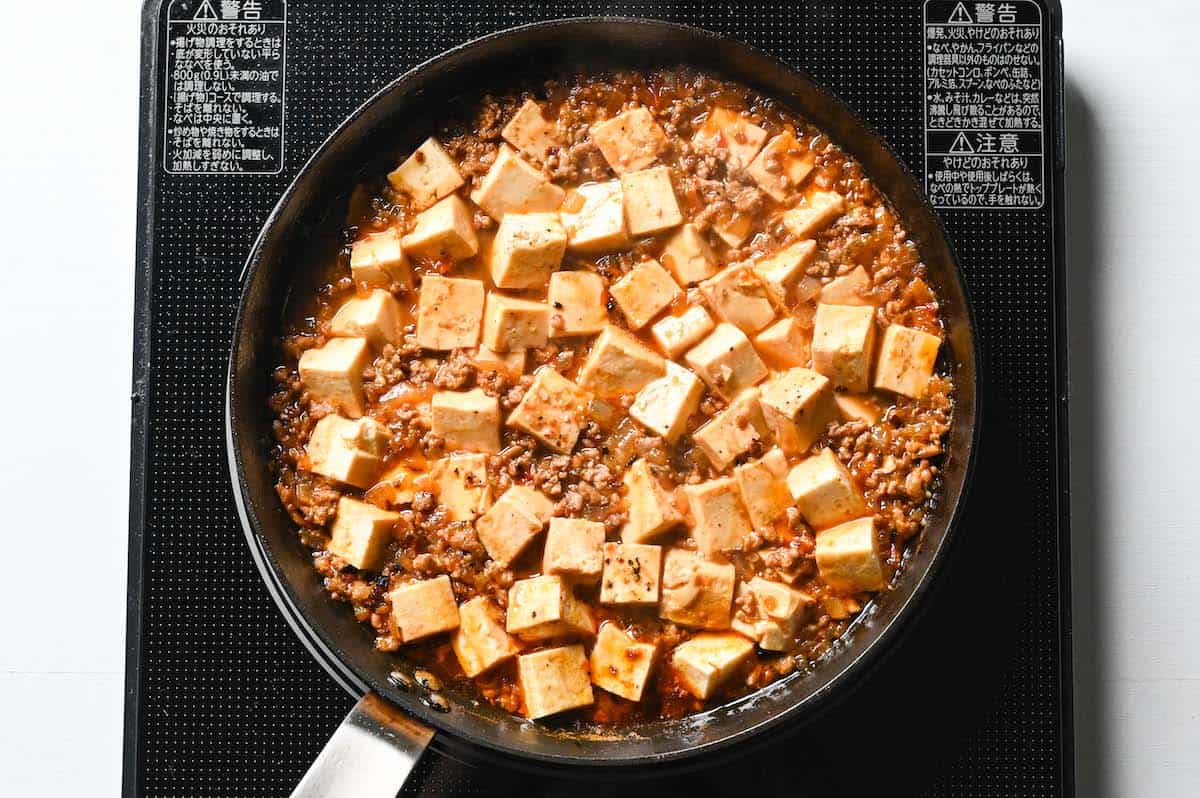
This dish balances five key flavor elements: sweet, salty, sour, bitter, and umami. If your sauce tastes flat while cooking, try adding a pinch of sugar. It’s not there to make the dish sweet, but to enhance the other flavors and round out the profile. The slight sweetness also helps to cut the heat of the toban djan.
Mix cornstarch and cold water in a small bowl to make a slurry. Stir well until completely smooth! This will prevent lumps from forming in your sauce. Pour the slurry into the pan and mix gently. The slurry will thicken the sauce and create the iconic glossy coating that adheres beautifully to the tofu.
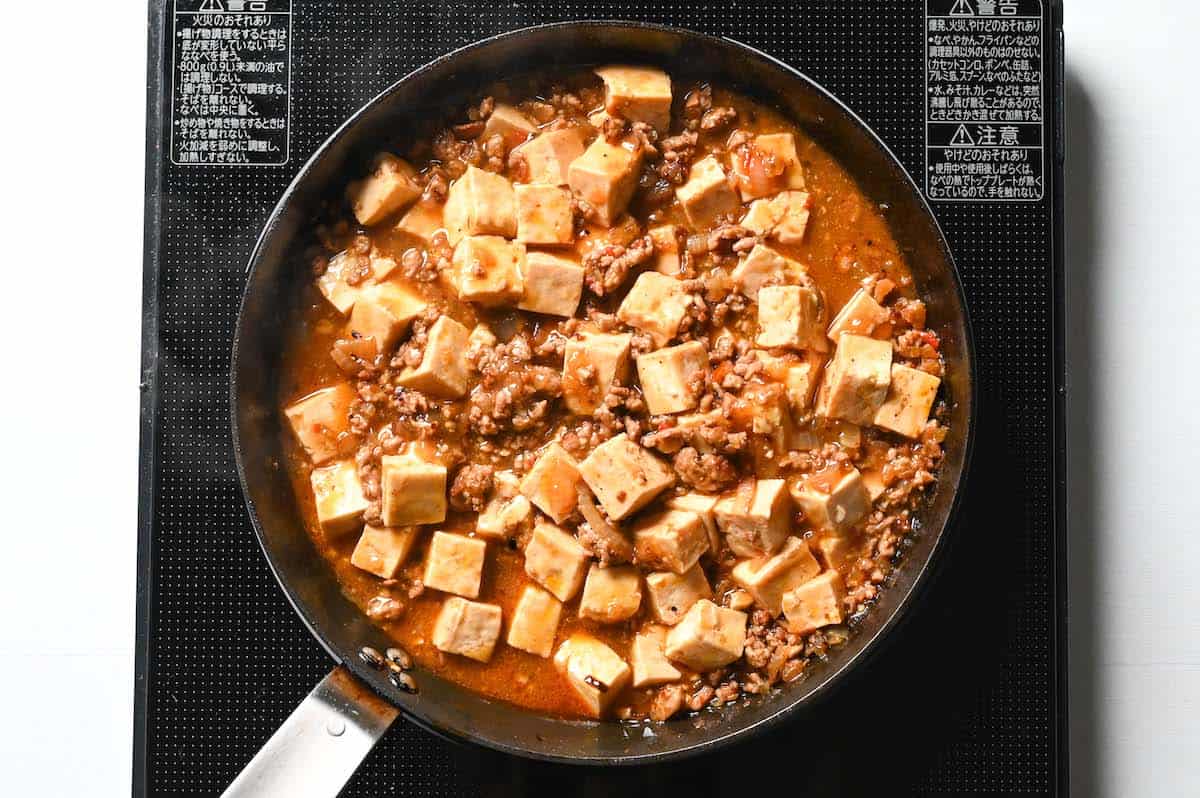
At this point, taste the sauce and adjust the seasoning if needed. You can add a drizzle of chili oil for extra heat, a touch more soy sauce for saltiness, or even a tiny pinch of sugar to balance the flavors. Once you’re happy with the taste, remove the pan from the heat.
- Black pepper
- Yuzu kosho
- Rice vinegar (only if you prefer a bit acidic)
- Sichuan pepper (if you prefer a bit more like Chinese flavor)
These are completely optional, and even if you do use them, please keep the amount to a minimum.
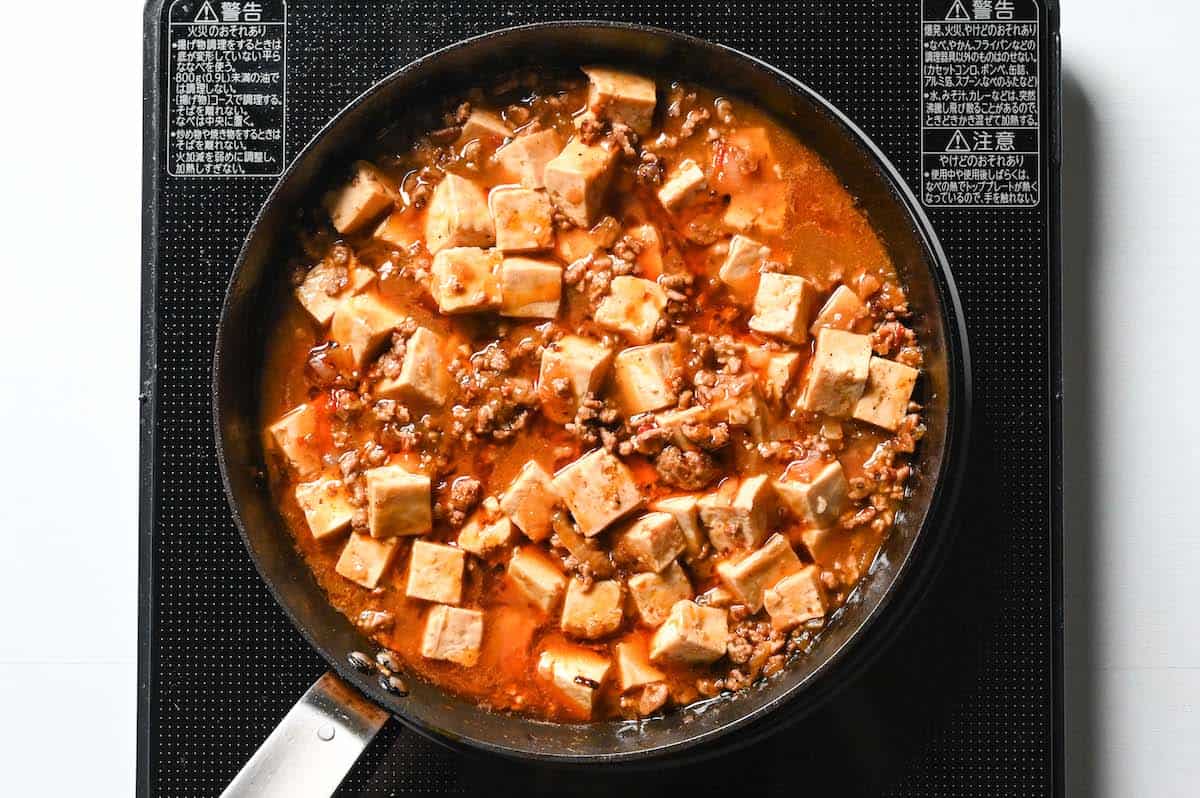
Dish up and sprinkle with chopped green onion and chili threads (optional) for color and flavor contrast.
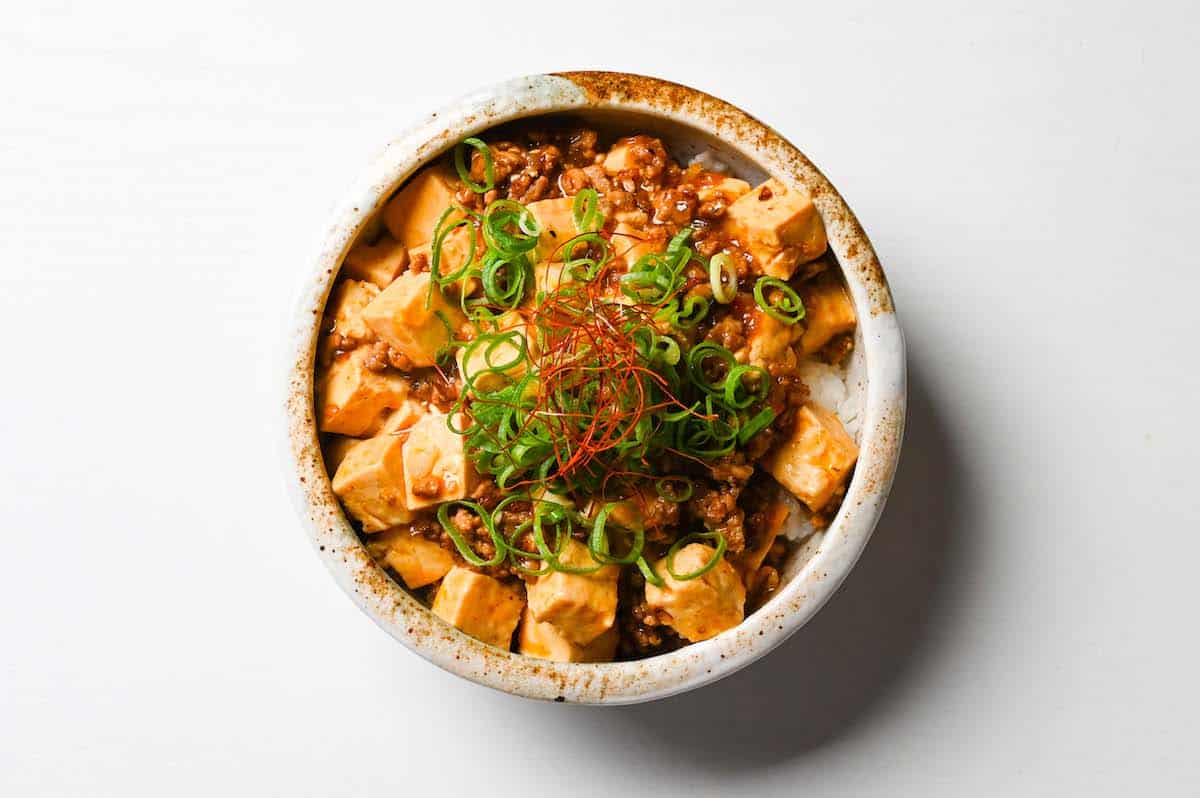
The normal way to enjoy mapo tofu is served over steaming hot rice, which provides the perfect neutral canvas for the flavorful sauce. I’ve got a guide on how to cook Japanese rice if you’re interested.
Essential Tips & Tricks
- Tofu handling: Choose firm tofu for beginners as it holds its shape better. When adding tofu to the sauce, gently shake the pan instead of stirring to prevent breaking.
- Perfect thickening: Mix cornstarch and cold water thoroughly before adding. Turn down the heat when adding the slurry, then simmer for 1-2 minutes afterward to cook out the starchy taste.
- Simmer patiently: Allow 6-8 minutes of gentle simmering for flavors to meld and tofu to absorb the sauce. This isn’t a quick stir-fry!
- Balance flavors: If your mapo tofu tastes flat, try adding a tiny pinch of sugar – not for sweetness but to enhance other flavors.
- Adjust spice level: For family-friendly versions, start with a small amount of tobanjan. You can always add more chili oil at the table for those who prefer it spicier.
- Rescue techniques: If your tofu breaks apart, embrace it and call it “crumbled tofu style.” If sauce is too thin, add more slurry; if too thick, add water tablespoon by tablespoon.
With these simple tips in mind, you’re set for success every time you make Japanese Mapo Tofu.
Meal Prep & Storage
Mabo dofu can work for meal prep, though with some important considerations that preserve flavor.
- Full Dish Prep: While mapo tofu is best enjoyed fresh, you can prepare the complete dish ahead of time. Store in airtight containers and consume within 2-3 days for best quality.
- Component Prep: A better approach is to prepare components separately. Make the meat sauce base without tofu or thickener. Cook ground pork with seasonings and aromatics through the simmering stage, then cool and refrigerate (2-3 days). When ready to eat, reheat the sauce base, add fresh cubed tofu, simmer briefly, then add the slurry to finish.
- Freezer-Friendly Option: Freeze in thin, flat portions in freezer bags or containers for up to 3-4 weeks. The tofu texture will change (becoming more firm and spongy), but some people enjoy this texture transformation. Alternatively, do the component prep and freeze so that you can add tofu on the day of serving.
Serving Suggestions
FAQ
Mapo Tofu is a dish created about 100 years ago in Sichuan Province, China by Mrs. Chen. The dish, made using local tofu and mutton, gained popularity in Chengdu and was named after its creator, with “Mapo” combining the Chinese words for “pockmarks” and “grandma,” translating to “Pockmarked Grandma’s Tofu.”
The dish’s introduction to Japan in the 1950s by Chinese chef Chen Kenmin led to adaptations for the Japanese palate, making it sweeter and less spicy. Its popularity further increased when Chen’s son, the renowned Iron Chef Chen Kenichi, featured it on television, solidifying Mabo Dofu as a staple in Japanese cuisine.
Japanese-style mapo tofu (mabo dofu) is much milder than the original Sichuan version. The key differences are: much less spicy with reduced chili oil and chili bean paste; little to no Sichuan peppercorn (花椒), eliminating the numbing sensation characteristic of Sichuan cuisine. The addition of miso paste for richness and depth often uses more everyday ingredients accessible in Japanese kitchens and generally uses less oil than authentic Sichuan versions.
The level of spiciness in this dish can vary based on personal tolerance. Personally, I experience it as mildly spicy, considering that I have a moderate tolerance for spicy foods, neither particularly high nor low. To tailor the spiciness to your preference, you can adjust the quantity of chili bean sauce used.
Yes! For busy weeknights, you can prepare the meat sauce base (without tofu or thickener) up to 3 days ahead and refrigerate it. When ready to eat, simply reheat the sauce, add fresh tofu, simmer briefly, and finish with the slurry.
Tobanjan, a key ingredient in Chinese-influenced Japanese cuisine, is a spicy Sichuan paste made from fermented broad beans, chilis, soybeans, salt, and pepper. It’s important to note there are two types: “la doubanjian” (spicy, red in color) and “doubajian” (milder, brown in color).
If tobanjan is not available, you can try sambal oelek (Indonesian), gochujang (Korean), or a mixture of miso paste and chili flakes, although these will taste different. If you like spicy food and Asian cooking, a jar of tobanjan is a great addition to your pantry!
Japanese mapo tofu is naturally family-friendly, but you can easily adjust the spice level. For very mild, use just 1/2 to 1 teaspoon of tobanjan, and don’t use chili oil at the end.
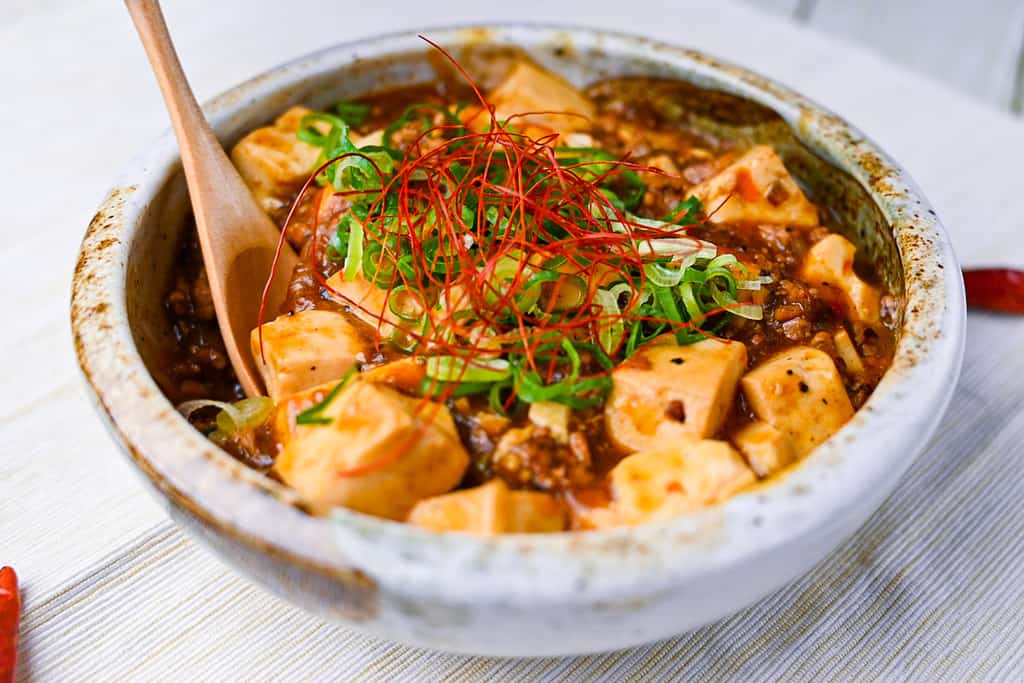
I hope you enjoy this Mabo Tofu recipe! If you try it out, I’d really appreciate it if you could spare a moment to let me know what you thought by giving a review and star rating in the comments below. It’s also helpful to share any adjustments you made to the recipe with our other readers. Thank you!
More Japanese Dinner Recipes
- Best Tonkatsu (Deep-fried Japanese Pork Cutlet)
- Hambagu (Japanese Hamburger Steak)
- Beef Hayashi Rice (Without Roux Packet)
- Teriyaki Beef Rice Bowl with Wasabi Twist
Want more inspiration? Explore my Japanese Dinner Recipe Roundup Post for a carefully selected collection of tasty recipe ideas to spark your next meal!
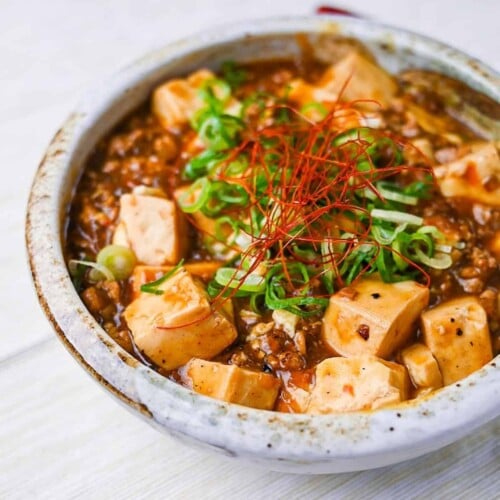
Japanese Mapo Tofu (Mabo Dofu)
Ingredients
Pork
- 100 g ground pork or beef/pork mix, other ground meat, minced soy meat
- 1 pinch salt and pepper
- ½ onion finely diced
- ½ tsp sake or dry sherry, dry white wine
- ½ tsp Japanese soy sauce (koikuchi shoyu)
- ½ tbsp yellow miso paste (awase) red/white mix, or red
- 1 tbsp toasted sesame oil
- ½ tbsp chili bean sauce (toban djan) adjust amount for spice preference
- 1 tsp grated garlic or garlic paste
- 300 g firm tofu
Broth
- 200 ml chicken bouillon or other types of bouillon of your choice
- 1 tbsp sake or dry sherry, dry white wine
- ½ tsp Japanese soy sauce (koikuchi shoyu)
- ½ tbsp oyster sauce mushroom sauce for vegetarian alternative
- ¼ tsp ground black pepper
- finely chopped green onions to garnish
- 2 tbsp cold water to make slurry
- 2 tsp cornstarch to make slurry, or potato starch
- 2 tsp chili oil (rayu) optional, adjust to taste
- chili threads optional garnish
My recommended brands of ingredients and seasonings can be found in my Japanese pantry guide.
Can’t find certain Japanese ingredients? See my substitution guide here.
Instructions
- Heat the pan on medium and add 100 g ground pork. Sprinkle it with 1 pinch salt and pepper and fry until browned. (You can add a little oil if it's sticking, but if you're using a non-stick pan, generally the pork has enough fat to prevent it from sticking to the pan.)

- Add the ½ onion (finely diced) to the pan and fry with the pork until slightly softened.

- Next, add ½ tsp sake, ½ tsp Japanese soy sauce (koikuchi shoyu) and ½ tbsp yellow miso paste (awase) and mix until evenly distributed through the pork.

- Push the pork to one side of the pan and on the empty side, add 1 tbsp toasted sesame oil, ½ tbsp chili bean sauce (toban djan) and 1 tsp grated garlic. Mix them together for about 30 seconds – 1 minute. Once fragrant, mix with the pork.

- Pour 200 ml chicken bouillon into the pan, add 300 g firm tofu (cubed) and bring the mixture to a boil, mixing occasionally. Once bubbling, turn the heat down to a simmer.

- Add 1 tbsp sake, ½ tsp Japanese soy sauce (koikuchi shoyu), ½ tbsp oyster sauce and ¼ tsp ground black pepper to flavor the sauce.

- Simmer until the sauce is reduced to about half, mixing occasionally.

- Take a small bowl and mix 2 tbsp cold water with 2 tsp cornstarch. Once smooth, add it to the pan and mix.

- Once the sauce has become thick and glossy, add 2 tsp chili oil (rayu), mix and turn off the heat.

- Sprinkle with chopped finely chopped green onions and chili threads (optional).

- Enjoy!
Video
Notes
- For vegetarians: Replace pork with a meat alternative and use vegetarian miso paste, mushroom sauce instead of oyster sauce, and vegetable bouillon.
- Miso options: Yellow (awase) miso paste works best, but you can use red or white miso, or mix red and white in equal parts to create your own awase miso.
- I recommend using an Asian-style chicken bouillon to make the stock. But you can also use other types of bouillon if that’s easier for you.
- To adjust spiciness: First, remove the chili oil topping for milder flavor, then substitute yellow miso for chili bean paste for an even milder version.
- Store leftovers in the refrigerator for up to 3 days. Reheat refrigerated Mabo Dofu in a microwave or pan before serving.
- Serving suggestions: cooked Japanese rice, mugen piman, sesame spinach salad, Japanese egg drop soup.
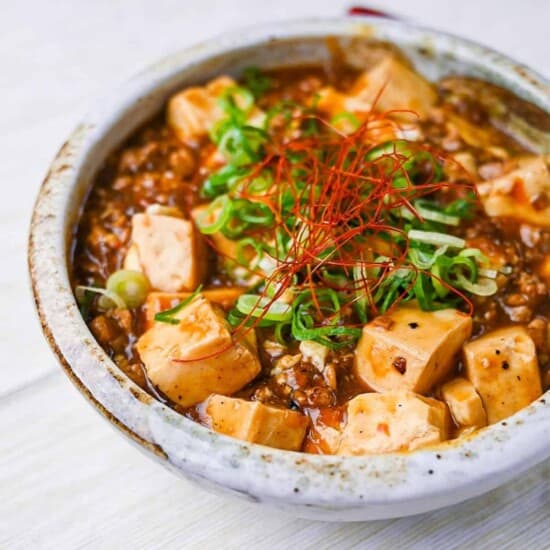





Delicious! Favorite mapo dofu recipe I’ve tried so far. I minced up some mushroom with turkey for the “meat” and that turned out well. Thank you for sharing!
Hi Amanda!
Thank you for your kind words and generous rating. Also, great idea using turkey and mushroom together!
Hi Yuto,
Great Mabo Dofu recipe. I used to make Mabo Dofu from a package, but I was glad to make it from scratch with your recipe. I added green beans. It was delicious.
Thank you
Hi Sam,
Thank you for trying the recipe, I’m glad you liked it. Also thank you for the rating 🙂
I’ve never tried it with green beans, nice idea!
oops, forgot to rate the recipe. 5/5
Hello have you used Gaban curry powder?
Hi James, Thanks for your question. I’ve used Gaban curry powder before but not in this recipe.
Cooking sake or regular sake? Appreciate the recipe!
Hi Stephen,
Sorry for the late reply.
Both can be used! Just be careful of the cooking sake that contains salt as it can alter the taste of the dish or make it too salty.
Hope you enjoy the recipe!
Great recipe! We always bought the ‘CookDo’ Mabo Tofu sauce when we lived in Japan. Needless to say…this is WAYYYY better! Thanks for the recipe.
Hi Spence,
Thank you for your kind words, glad you enjoyed the recipe!
So good! I made it pescatarian by using vegetable stock and impossible ground beef. Can’t wait to make it again!!
Thank you very much for the comment and sharing your experience! I’m glad the recipe worked well with a meat alternative too!
Hallo Yuto.
Ich liebe Mabo Tofu.
Liegt mitunter an der Chili bean sauce. <3
Lieben Dank wie immer für das Rezept.
Auch wenn du viele neue aufregende Rezepte postest, koche ich auch gerne die die älter sind und länger zurückliegen, immer wieder gerne.
Gute Zeit, bleibt gesund. Bis bald
Gruß Kathleen
Hallo Kathleen,
Danke für das Bild und den Kommentar, wie immer! Ich liebe auch chili bean sauce, vor allem die Schärfe und das Aroma!
Es freut mich, dass Ihnen meine älteren Rezepte gefallen haben! Die alten sind meistens die Klassiker!
Sie auch, Kathleen, ich freue mich, wieder von Ihnen zu hören.
Mit freundlichen Grüßen,
Yuto
First time making this dish and it was delicious! It did not look like yours for some reason (followed instructions exact) but delicious none the less! Thank you for sharing
Hi Robbie,
Thank you so much for trying this recipe and sharing your picture! Looking great!
I’m so glad you enjoyed it! 🙂
Yuto
Love this.
Recipe is now printd off and in my keep file!
Hi Trish,
Thank you! It makes me so happy to hear you enjoyed the recipe and added it to your collection. Hope you make it again! 🙂
Yuto
Loved this. Have printed it off and now in my keep file
I just had this for dinner…..!!!?
so tasty.
Thank you so much for trying this recipe, Trish! 🙂
I had never had Mapo Tofu before but I knew I wanted to try it. I had to substitute regular hot sauce for the chili bean sauce, but it was still delicious and I will definitely make it again. We had it with noodles.
For my own taste I would probably add some veg in the future: wilted spinach or peas.
Hi De,
Thank you for trying my recipe! I’m so glad you enjoyed it. Adding vegetables sounds like a wonderful variation! 🙂
Yuto